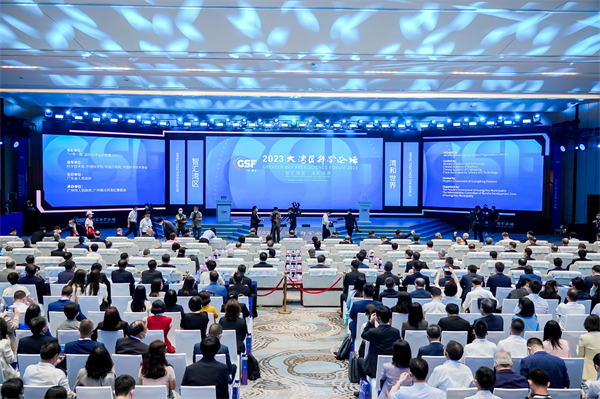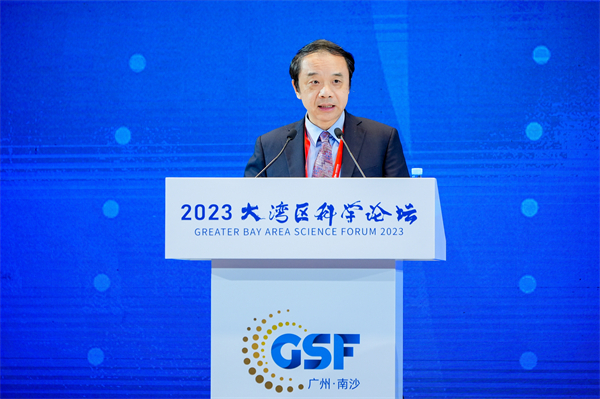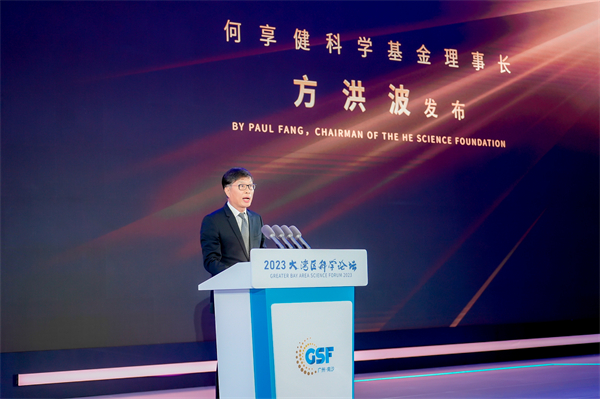GBA's hardcore scientific and technological strength
As one of the highest-level scientific events in the Guangdong-Hong Kong-Macao Greater Bay Area, the four-day 2023 Greater Bay Area Science Forum came to a close in Guangzhou's Nansha district, Guangdong province, on May 23. The forum gathered more than 100 top scientists and academicians to explore the future of technological innovation in the Greater Bay Area and cutting-edge technological issues.

A photo taken on May 21 shows attendees at the opening ceremony of the 2023 Greater Bay Area Science Forum in Guangzhou, capital city of South China's Guangdong province. [Photo/gsf.org.cn]
Hardcore: Fundamental research and cutting-edge achievements
Strengthening fundamental research is an urgent requirement for achieving high-level scientific and technological self-reliance and the key path to building a world-leading powerhouse of science and technology.
Guangdong, at the forefront of economic development, encountered "bottlenecks" in technological innovation earlier than other regions.
Realizing the importance of independent innovation, Guangdong has made significant investments in basic research and technological breakthroughs with fundamental models, major national projects and platforms such as the China Spallation Neutron Source and the Daya Bay Reactor Neutrino Experiment and Jiangmen Underground Neutrino Observatory. Others include Peng Cheng Laboratory, Guangzhou Laboratory, Songshan Lake Materials Laboratory and Ji Hua Laboratory.
In 2021, Guangdong invested 27.4 billion yuan ($3.8 billion) in basic research, accounting for 6.85 percent of its total R&D expenditure, surpassing the national average.
Significant achievements have been made alongside the construction of a series of hardcore platforms. From 2017 to 2022, eight research achievements led or participated by Guangdong were included in the annual China's Top 10 Scientific Advances. Guangdong's competitiveness in basic research rose from third place in 2017 to second place in 2022.
"There will be many important scientific discoveries at Guangdong's large scientific facilities in the future," said Wang Yifang, director of the Institute of High Energy Physics of CAS.

Wang Yifang, a deputy to the National People's Congress, academician of the Chinese Academy of Sciences (CAS), delivers his speech at 2023 GSF session on high-energy physics and application: development of basic and interdisciplinary sciences. [Photo/en.gsf.org.cn]
Balanced ecosystem: S&T star enterprises become GBA's signs
Technological innovation thrives on a strong ecosystem. In the GBA, the vibrant industry-academia-research ecosystem is driving the transformation of original innovations into technological productivity.
Guangdong has put forward the concept of building an innovative ecological chain that encompasses "fundamental research, technological breakthroughs, achievement transformation, scientific finance and talent support".
During the forum, many examples of industry-academia-research collaboration were presented.
In the industrial sector, leading enterprises actively collaborate with academic institutions. "Huawei has established the ICT (Information and Communication Technology) Academy, where new technologies are integrated into the curriculum through collaboration with academic institutions. The academy aims to enhance the capabilities of ICT teachers and help students obtain ICT-related professional certifications," said Wang Chengjie, director of Talent Development for Chinese Government and Enterprises at Huawei Technologies.
In the academic field, higher education institutions actively embrace new business models.
"Based in the GBA, the Hong Kong University of Science and Technology (Guangzhou) will promote transfer of knowledge innovation and the transformation of scientific achievements. It aims to incubate emerging industries with new technologies and become an important engine for innovation-driven development in Nansha and the GBA," said Lionel M. Ni, founding president of HKUST (GZ).
In the research sector, new research and development organizations continue to emerge.
"In the next 10 years, Shenzhen Medical Academy of Research and Translation will gather 200 research teams, focusing on cultivating the next-generation medical scientists who have both clinical and research capabilities," said Yan Ning, founding dean of the Shenzhen Medical Academy of Research and Translation and director of the Shenzhen Bay Laboratory.
The inauguration of the He Science Fundation was announced during the forum, with a donation of 3 billion yuan from He Xiangjian, founder of Midea Group, to fund more scientists in conducting research.

Paul Fang, chairman of Midea Group, announces the He Science Fundation at the 2023 Greater Bay Area Science Forum.[Photo/en.gsf.org.cn]
Data show that since 2018, the annual average growth rate of high-tech enterprises in Guangdong has been maintained at 16 percent with a total number of over 69,000, ranking first in the country for seven consecutive years.
Unique location: the synergy among GBA creates powerful competitiveness
"Guangzhou, Shenzhen, Hong Kong and other GBA cities have many differences, but they can maintain open and close interactions, which will create a very strong competitiveness," summarized by Michael Levitt, 2013 Nobel Laureate in Chemistry and Stanford University professor, during the 2023 GSF.
In other words, GBA's natural S&T innovation strength is the result of complementary advantages among Guangdong, Hong Kong and Macao, which is manifested in several aspects:
Strong scientific research strength: The GBA has multiple well-known universities and research institutions, including several universities among the top 100 in the world.
According to authoritative rankings, the "Shenzhen-Hong Kong-Guangzhou Science and Technology Cluster" has ranked second in the Global Innovation Index for three consecutive years by 2022.
Innovative policy connections: The GBA has taken the lead in exploring the connection of innovative rules and mechanisms among the regions such as cross-border fund transfers, talent exchanges, tax balance and logistics connections. By the end of 2022, Guangdong had cumulatively allocated more than 370 million yuan in cross-border research funding.
Abundant talent pool: "Whether from the perspective of a young population structure or the proportion of educated population, GBA's talent vitality should be at the forefront of the country," Gong Peng, vice-president of the University of Hong Kong, said.
The Hong Kong branch of the Southern Marine Science and Engineering Guangdong Laboratory (Guangzhou) has attracted 101 scientists from 23 research institutions in eight countries. Many of them come from top institutions around the world.
Guangdong has partnered with Hong Kong and Macao to establish 20 joint laboratories; and the GBA has established 31 innovative platforms in Hengqin, 125 innovation carriers in Qianhai and 132 high-end innovation platforms in Nansha.
Now, with the synergy of these regions, the advantaged scientific innovation strength in the GBA is showing up. More and more S&T talents are pursuing their dreams there.












